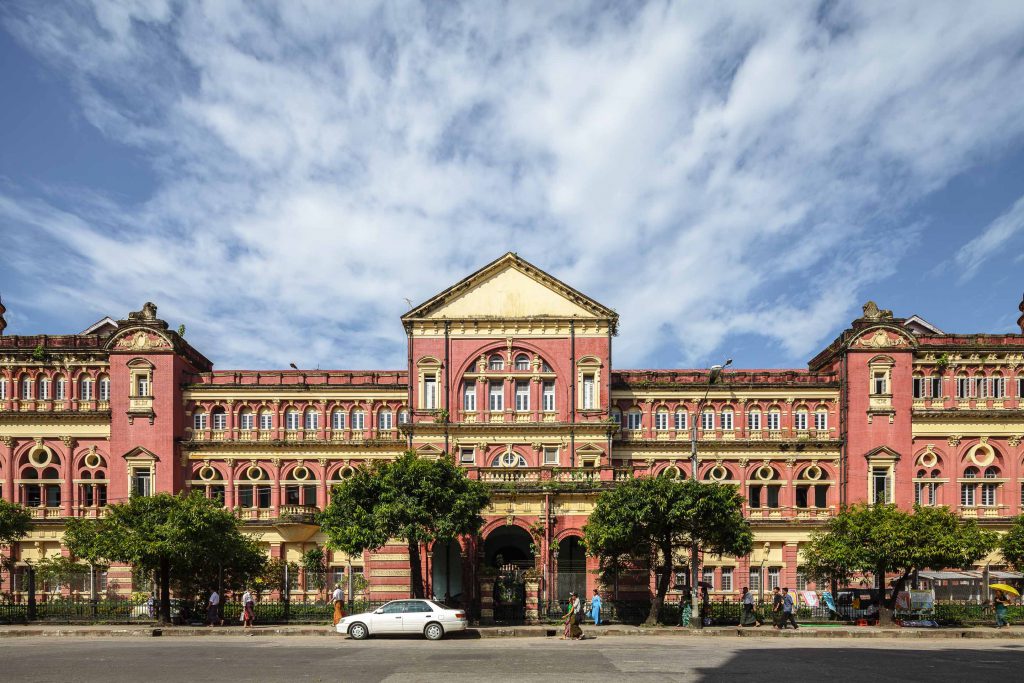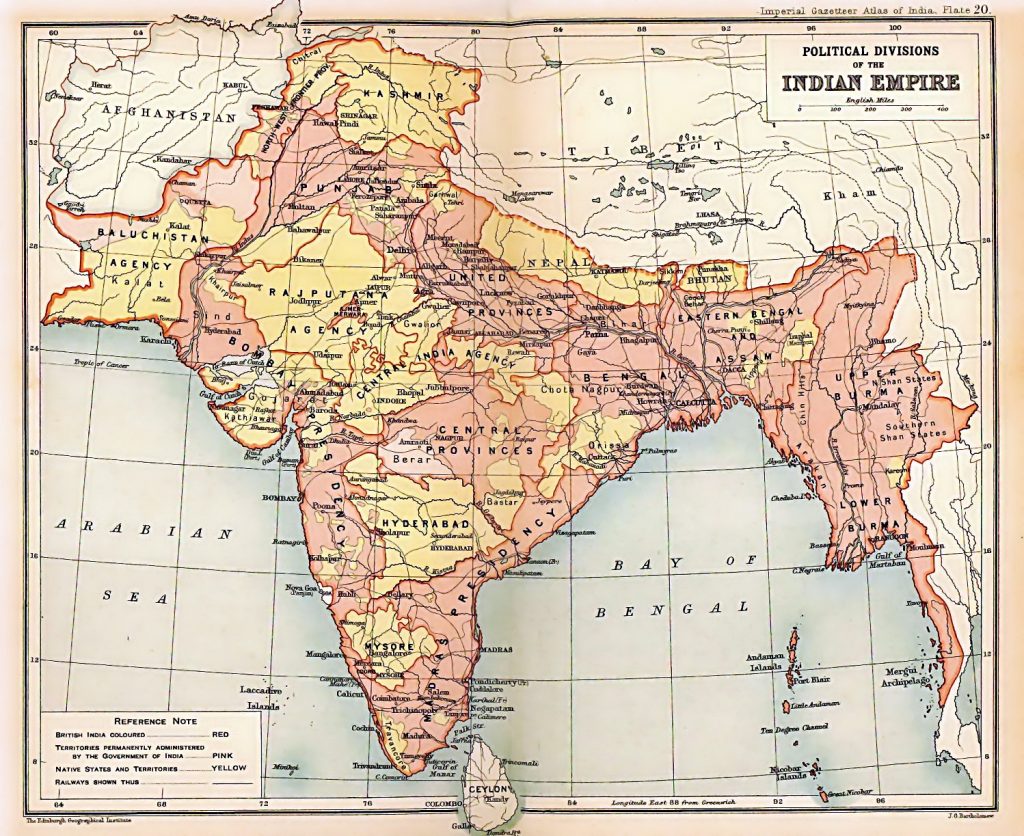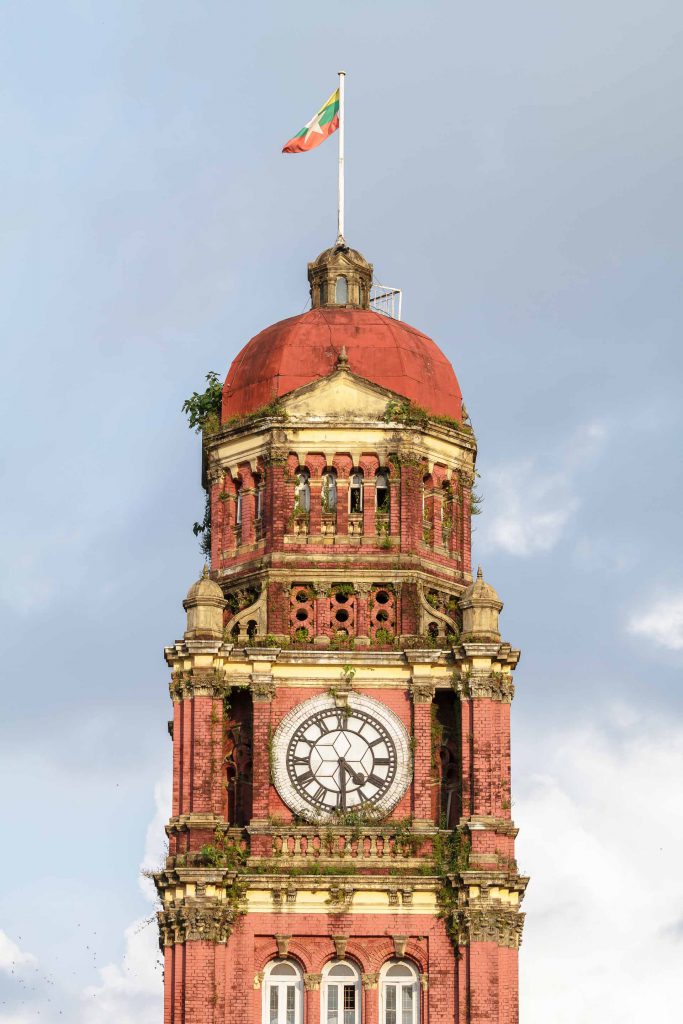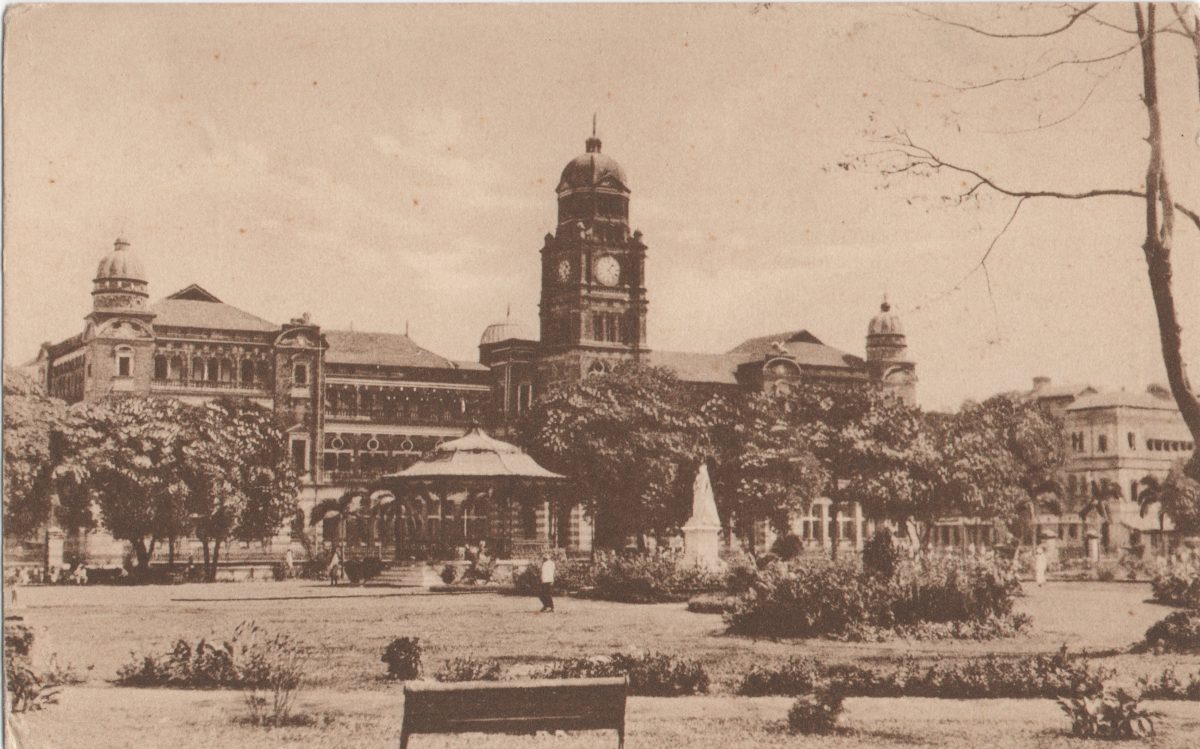Historically known as Burma, present day Myanmar has gone through significant transformations in power structures and national identity. This struggle can be symbolically represented through the architectural presence left by imperialist superpowers, most commonly, Great Britain. The imposition of architectural styles is one method of establishing empire and declaring power over a nation. Its strong presence is seen through its juxtaposition against surrounding vernacular typologies as well as deliberate programming of said architectural assertions. Most often these buildings represent that of political, economic, religious, or educational dominance. In the case of Yangon, historically known as Rangoon, the old capital of Burma, political dominance tuned colonial legacies can be found with the erection of the High Court Building in 1911.[1] Serving at the time, as the site of all judicial matters from high to supreme court, this building demands attention amongst the Burmese landscape.[2] Often referred to as a “Queen-Anne”[3] style or most appropriately “Indo-Saracenic” style of architecture, its presences are a display of dominance in a landscape deemed as “the Other”. The High Court Building establishes itself as a marker of colonial supremacy in Burma, through a means of political discourse. The assertion of a new colonial architectural style that was derived from the amalgamation of a colonized state (India) and colonizer (Britain), aids in understanding Britain’s liberty to act as they please and positions Burma as a colonial possession within a colonial possession. The declaration of an architecture that is neither wholly British nor Hindu, in this context is one to be analyzed.

To understand the British control in Burma, it is important to understand their grounds for adding Burma to their arsenal of colonial dominance. Deriving from three Anglo-Burmese wars (1824-1826, 1852-1853, 1885), what was once the greatest empire in South East Asia, the kingdom of Burma was annexed by British powers.[4] This resulted in two competing Burma’s, a gradual shrinkage of Northern Burma where its independent state was still intact versus the expanding colonial south.[5] Colonial impositions included the introduction of administrative reforms and the integration of newly developed Western technologies in order to modernize their court politics and “poorly developed economy”.[6] The perception of Burma today lends itself to false pretenses of indigenous culture, but as a colonial construct curated by British rule. This can be understood with this quote from, A History of Modern Burma,
“The foreign imagining of Burma had little to do with how Burmese viewed their own country – that is, how Burma was viewed from the inside. For the most part, indigenous chronicles and literature, the local monastery or spirit shrine, the general continuity of precolonial material culture, and a range of other survivors of the British annexation continued to shape daily life and perspectives on the vast rural landscape well into the twentieth century. The most serious challenges to the continuity of precolonial social and cultural life would occur in the colonial capital at Rangoon”.[7]
After the second Anglo-Burmese war, lower Burma was annexed and put under control of British India.[8]In this second phase of colonialization, the capital of Burma, Rangoon (Yangon) was annexed.[9] British rule expanded to upper Burma by the third Anglo-Burmese war.[10] The root of British control in Burma can be understood through the long and intense geopolitical rivalry with France.[11]

The imposition of Western values and way of life are no strangers to colonial rule and control. In efforts to “modernize” a system that was not up to the standards of Western perspectives, it alters the discourse of everyday life. A social structure that does not conform to Western, in this case British, values result in it being deemed “the Other”, disregarding centuries of indigenous values and systems, that before colonial rule, worked. An example of this alteration can be seen in population control and necessity to label every aspect of human identity. In the text, A History of Modern Burma, they explain that,
“The colonial state, through a series of censuses taken in 1872, 1881, and every tenth year thereafter until 1931 demanded information on every aspect of people’s lives, from their occupation to their religion, and about every member of the household. The collection of census data was problematic. In many spheres of Burmese life, identities and identifications that were fluid, syncretic, multiple, or even undefined were common”.[12]
The alterations of social structure posed by colonial rule creates a system of “this or that”. Similar to understanding what is western and modern versus “the Other”, the categorization of human identification was seen as a method of “organization”. This becomes a political statement of belonging to a system of social ideals. Indigenous values and culture being lost to western social.
Burma can be understood as a colonial possession within a colonial possession. Great Britain creates a hierarchy in their conquests, India being one of their many prized colonies, puts Burma below them as it becomes a subcategory to British India. Therefore, the liberation of Burma relies not only from Great Britain, but also from India. This nesting doll approach to imperialism can be understood further through the architectural styles imposed on the Burmese landscape. In particular, the political and social influence of the High Court Building, and how its design continues the narrative of empire building in Burma.
The High Court Building was a site for all judicial matters from high to supreme court cases before the change of capital cities.[13] Located in Rangoon (Yangon), Burma (Myanmar), this building took six years to construct from 1905 to 1911.[14] Designed by architect, James Ransome this building can be described as an Indo Saracenic style of architecture.[15] It is important to point out why this style of architecture? In many cases before, The British established its empire with styles such of Georgian, neoclassical, neo-gothic, and many others, so why the introduction of a newly derived colonial style in Burma? To understand the design of the High Court Building, it is crucial to define what Indo-Saracenic architecture means. At the time of its emergence, the amalgamation of Hindu and British architectural styles was reserved to many elitist building programs such as educational institutes and museums.[16] In the text, Architecture and the Representation of Empire India, 1860 – 1910, Thomas R. Metcalf describes,
“The Indo-Saracenic style by contrast ideally suited the needs of British colonialism. In it not only could the distinct “Hindu” and “Saracenic” forms be melded, but the British, self-proclaimed masters of India’s culture, could in the process shape a harmony the Indians themselves, communally divided, could not achieve”.[17]
Declaring themselves masters of a culture ultimately declares themselves as teachers of it as well. The position of a teacher is to spread and share knowledge. The British, took upon themselves to become the teachers of their version of Indian culture and establish its presence in Burma. The proclamation of Burma as a province of India, can be seen architecturally with the High Court Building. Its mass scale and political connotations demand the knowledge of colonial presence. Its Indo-Saracenic style further emphasizes Burma as a colonial possession within a colonial possession. Keeping true to its colonial annotates, the clock tower is a prominent figure in many colonial buildings by British imperialist. The clock tower is a significant element as it symbolizes the beginning of “new era” in where they empire.[18] In the context of the High Court Building, this “new era” pertains to the legal system of Burma. The introduction of a British legal system alters generations of future Burmese politicians and lawyers during and post-colonial rule. British trained Burmese lawyers are responsible for fairly recent constitutions.[19] This further probe the idea of colonial legacies beyond physical objects, such as architecture. But how this architecture represents generations of systems and structures that cannot be reformed immediately after liberation.

Colonial rule in Burma can be symbolically represented with the introduction of the High Court Building. Its Indo-Saracenic architectural style declares Burma as a colonial possession within a possession, further probing Britain’s ability to establish an empire during the peak of imperialism. During an ongoing geopolitical rivalry with France, the proclamation of Burma as a province of British India established a new lens of power through colonial hierarchy. This building becomes a physical manifestation of the generations of colonial structures and legal systems instilled in Burma, Myanmar, today.
Endnotes
[1] “Yangon Region Court,” Architectural Guide Yangon, Accessed April 22, 2021, https://www.yangongui.de/yangon-region-court/.
[2] Ibid.
[3] Felix Girke, “The Yangon Court Buildings: Between Thick and Thin Heritage,” Sojourn: Journal of Social Issues in Southeast Asia 30, no. 1 (2015): 77.
[4] Michael W Charney, A History of Modern Burma, Cambridge: Cambridge University Press, 2015, 5.
[5] Ibid.
[6] Ibid.
[7] Ibid., 6.
[8] DAN SENG LAWN, “Burma/Myanmar: A Fulcrum Of Great Power Politics,” World Affairs: The Journal of International Issues 19, no. 4 (2015): 110.
[9] Ibid.
[10] Ibid.
[11] Ibid.
[12] Michael W Charney, A History of Modern Burma, Cambridge: Cambridge University Press, 2015, 8.
[13] “Yangon Region Court.” Architectural Guide Yangon. Accessed April 22, 2021. https://www.yangongui.de/yangon-region-court/.
[14] Ibid.
[15] Ibid.
[16] Thomas R. Metcalf, “Architecture and the Representation of Empire: India, 1860-1910,” Representations, no. 6 (1984): 50.
[17] Ibid., 49-50.
[18] Ibid., 56.
[19] Felix Girke, “The Yangon Court Buildings: Between Thick and Thin Heritage,” Sojourn: Journal of Social Issues in Southeast Asia 30, no. 1 (2015): 94.
Figures List
Feature Image | Sharman. “ABM 4029 High Court Building Rangoon.” Chasing Chinthes. October 21, 2018. Accessed April 22, 2021. http://www.chasingchinthes.com/abm-4029-high-court-building-rangoon/.
Figure 01 |”Yangon Region Court.” Architectural Guide Yangon. Accessed April 22, 2021. https://www.yangongui.de/yangon-region-court/.
Figure 02 | Vankani, Vriti. “British Era- When India and Burma Were Together.” The Kootneeti. September 08, 2020. Accessed April 23, 2021. https://thekootneeti.in/2020/09/03/british-era-when-india-burma-were-together/.
Figure 03 | “Yangon Region Court.” Architectural Guide Yangon. Accessed April 22, 2021. https://www.yangongui.de/yangon-region-court/.
Works Cited
Charney, Michael W. A History of Modern Burma. Cambridge: Cambridge University Press, 2015.
Girke, Felix. “The Yangon Court Buildings: Between Thick and Thin Heritage.” Sojourn: Journal of Social Issues in Southeast Asia 30, no. 1 (2015): 72-104. Accessed April 26, 2021. http://www.jstor.org/stable/24779830.
Keck, Stephen L. “Picturesque Burma: British Travel Writing 1890-1914.” Journal of Southeast Asian Studies 35, no. 3 (2004): 387-414. Accessed April 26, 2021. http://www.jstor.org/stable/20072606.
LAWN, DAN SENG. “Burma/Myanmar: A Fulcrum Of Great Power Politics.” World Affairs: The Journal of International Issues 19, no. 4 (2015): 108-29. Accessed April 26, 2021. https://www.jstor.org/stable/48505250.
Metcalf, Thomas R. “Architecture and the Representation of Empire: India, 1860-1910.” Representations, no. 6 (1984): 37-65. Accessed April 22, 2021. doi:10.2307/2928537.
“Yangon Region Court.” Architectural Guide Yangon. Accessed April 22, 2021. https://www.yangongui.de/yangon-region-court/.
